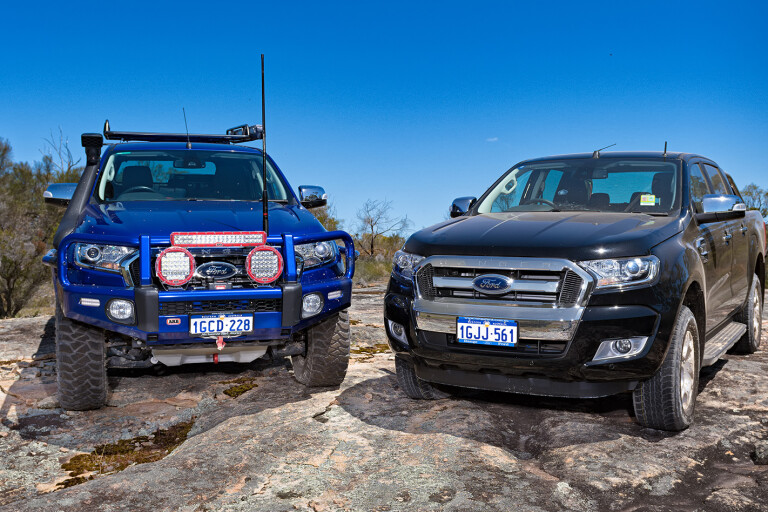
IT’S A hard ask of any manufacturer to provide a vehicle that delivers a commodious interior yet turns and parks on a paper plate.
One that can accelerate like a motorbike, can pull the QE2 yet sip fuel like a sparrow, and can glide through corners like an F1 car despite having a tonne in tow. The day they build a ute that is all things to all people is the same day we’ll all be driving it.
Until then we can expect compromise, as manufacturers try to best balance performance, practicality, function and form. However, as owners want to change some of those balanced compromises to better suit their own requirements, there’s a thriving multi-billion-dollar aftermarket industry.
Before we turn to the booming aftermarket world, we’ll look at the benefits a well-designed and engineered base vehicle affords. The Ford Ranger, for example, is well-known for its rugged good looks, comfortable ride, roomy interior and honest off-road capability. It’s a winner with families, tradies and grey nomads and, with strong sales in 2017, it looks like its popularity and strength in the marketplace is set to continue.
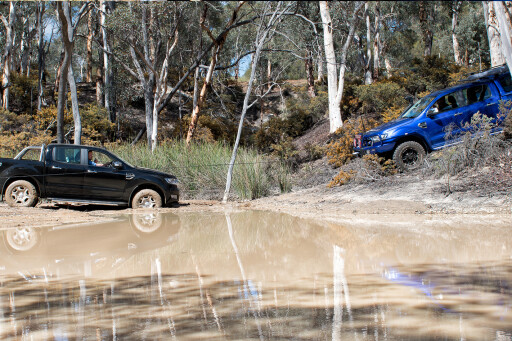
But has Ford left enough wiggle room to finesse the Ranger’s impressive capability? Enter our 2017 Ford Ranger XLT PX Mk II with optional auto gearbox – a 4x4 double-cab with an e-locking differential and 3.2 litres of muscle producing 147kW and 470Nm. It was purchased from the showroom floor with just 16km on the clock, gloss black paint and all. On the other side of the ring stands a menacing-looking Ranger finished in Winning Blue and sporting an A-grade list of who’s who in 4WD accessories.
More akin to Mike Tyson than its Tom Hanks opponent… surely this wasn’t going to be a fair fight. The first tick of approval was awarded to the modified Ranger’s enhanced and raised BP-51 suspension system. Simply because, long after suburbia was a rough edge on the horizon, we still hadn’t noticed it was there.
Smooth and comfortable, it was completely forgettable because it was that good. The same can’t be said for the persistent drumming of the tyre’s aggressive tread pattern, but they would prove their worth later (did I mention compromise?).
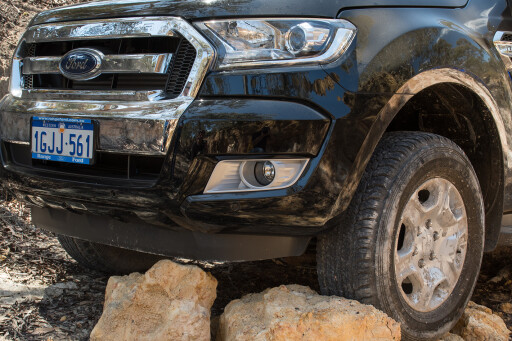
The premium BP-51 kit is designed to improve the off-road experience without adversely impacting on-road performance, so, on-road, the modified Ranger and stock Ranger are relatively similar. After all, what good is extra lift to clear off-road obstacles if the vehicle handles like a bucket of warm water on the drive home? However, as soon as we hit secondary gravel roads, the BP-51 kit started to justify its considerable price tag, as the modified Ranger continued to display an almost on-road level of comfort and smoothness.
Good directional stability allowed us to easily maintain momentum through sweeping corners, despite encountering several sections of rough corrugations. This is in part due to the method of progressive dampening using the BP-51’s internal bypass technology, like that used for off-road competition racing to provide impressive and consistent control when reaching the outer limits of compression and rebound. Allowing the oil to move through and around the piston, the BP-51 has five stages of dampening for both rebound and compression, and these can also be externally adjusted independently to suit ride, load and driving conditions.
The modified Ranger had a little more weight up front with a bullbar and winch, and it was running 300kg springs to offset the long-range tank, rear step, drawers, fridge, canopy, etc. However, despite having a rear with leaf springs – not normally conducive to a smooth or stable ride – the Ranger was remarkably settled, providing exceptional level of comfort and control. Not so the OEM counterpart. The standard shock absorbers strained trying to maintain consistent control over the corrugation’s short rebound oscillations, which translated into noticeable cabin vibrations, with the vehicle displaying a skittish reaction to surface irregularities.
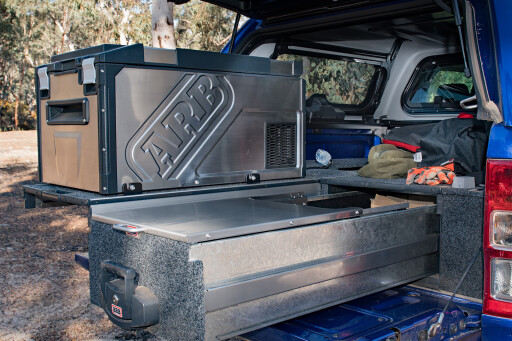
Throw a directional change into the mix, and the limited traction meant it wasn’t long before the electronics intervened. Given this narrow range of control offered by the standard shock absorbers, it’s slower going on the rough stuff for the OEM Ranger. On less-defined bush trails the ability to flex over undulating terrain and provide wheel articulation to maintain traction takes priority, as opposed to dampening control and stability at speed.
The BP-51 suspension was noticeably smoother, and it better isolated the driver from the jarring of small, sharp bumps and dips. This also pays dividends by reducing driver fatigue over extended trips. The modified Ranger was the first to ascend a slippery hill with off-camber dips and hollows. With the wheels compressing and extending almost beyond the wheel arches, our blue test mule twisted and contorted into positions that would have made a yoga instructor pass out. With only minimal wheel-slip at the extremity of the suspension travel, the modified Ranger completed the challenge with assertive confidence.
As the OEM Ranger began the climb it looked like it might succumb to wheel-spin, until we engaged the e-locker at the rear to settle things down. The bog-standard Ranger then demonstrated beyond doubt why it’s a formidable base on which to build a long-distance tourer, impressing everyone with its out-of-the-box determination and ability. At the very top, a deep hollow on one side saw the standard OEM run out of travel by a bare 10mm.
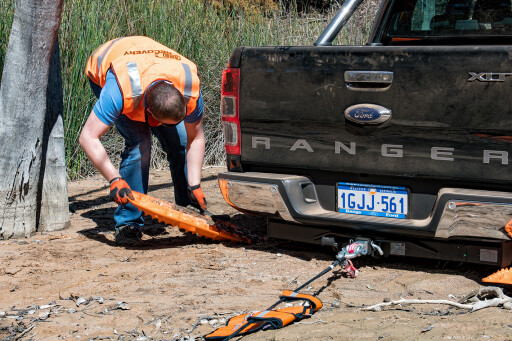
If not for the e-diff transferring torque across the axle, Round Two might have gone the way of Winning Blue. The standard Ranger was also competent when traversing loose rock and deep washouts through the valley trails; though, we had to make several cautious stops to road-build through sections the modified vehicle walked through.
Let’s be honest, the Ranger is no shrinking violet; the dimensions of the front grille and surrounding bodywork have about as much practical application for off-road driving as a bull in a china shop. And, with a claimed unladen approach, departure and ground clearance of 29, 21 and 237mm respectively, the Ranger’s not agile when manoeuvring in tight places on uneven ground. The rear tow bar assembly screams impromptu plough, complete with guide fins to thoroughly embed you into terra firma.
Plus, we had to be very cautious traversing crossovers, as the decorative sidesteps constantly hindered the standard Ranger’s ability to cross even the most moderate of angles. A peak underneath both vehicles revealed a few more differences. Remote canisters mounted to the BP-51 suspension system ensure it runs cool even under demanding conditions, and solid, robust tubing and mounting points are designed to withstand the impacts of off-road adventure.
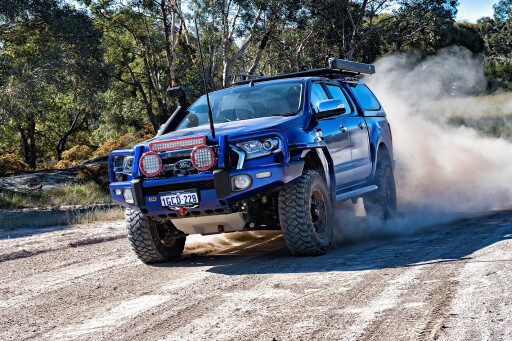
An electric winch mightn’t be a necessity, but we demonstrated how handy it was to have one neatly mounted into a rated bullbar and easily accessible behind a flipping number plate. Yep, we discovered a water-sodden clay pan lay beneath the crusty surface we’d stamped our feet across, and our OEM Ranger’s wheels broke through that crust and dropped us chassis-rail-deep in goop. This is when the modified Ranger’s winch and aggressive MTZs proved their worth.
With lots of digging, and a rear-line pull from that helpful winch, the Ranger was finally free… but having lost our path back we needed to carefully plot a new path around the side. Once again, the modified vehicle, with its extra ground clearance and enhanced approach and departure angles, made light work of the tricky 45-degree exit, and the clever upswept wings on the side of the modified bullbar allowed the tyres to gain purchase for a side angle step-up.
Unfortunately, the stocker required more digging and road-building before we could head home. At day’s end, all the accessories hadn’t morphed a standard Ranger into some form of super vehicle; they had enhanced the capabilities that already existed and unlocked the Ranger’s hidden potential to achieve what is essentially a formidable long-distance tourer with outstanding off-road capability. If you were to choose one upgrade, make it the BP-51 suspension system, as it took the Ranger’s solid driving dynamics to a new level of driving pleasure.
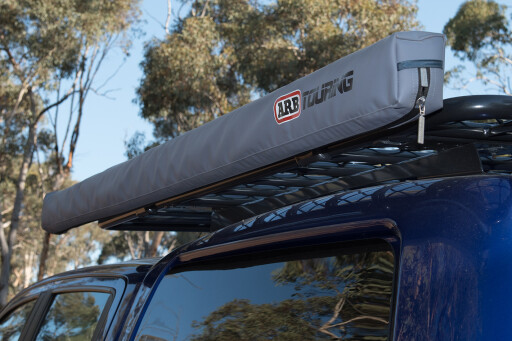
The bullbar, side rails, underbody protection and rear step all served a purpose beyond their aesthetics, by either protecting the vehicle or aiding off-road practicality. Other kit – driving lights, rear drawers, fridge, canopy, comms and roof rack – all added significant improvement and usability to the vehicle’s existing design.
It’s a combination of these accessories that turns a great product into a well-set-up vehicle for extended touring and off-road adventure.
Ford Ranger Kit
Keen to know what our modified Ranger was wearing so you can budget for your Christmas list?
BP 51 suspension kit (including 300kg rear springs): $4351.20
Summit bar: $2270.10 + $275 (colour coding)
9.5 XP Warn with Spydura rope: $3103.80
Summit side rails and steps: $1224.30 + $260 (colour coding)
Intensity AR32 LEDs: $1733.55
Intensity AR40 light bar: $887.25
ARB recovery point: $329.70
ARB under vehicle protection: $651
Ascent canopy (rear): $3952
ARB alloy canopy rack: $1350.30
Summit rear bar: $1571.85 + $90 (colour coding)
Safari snorkel: $485.10
ARB front locker: $999
ARB rear locker: $999
ARB high-output compressor: $388.50
Outback Solutions drawers: $2526.30
Frontier 140L fuel tank: $1092
ARB seat skin covers: $292.95
Elements s/steel fridge: $1783.95

COMMENTS